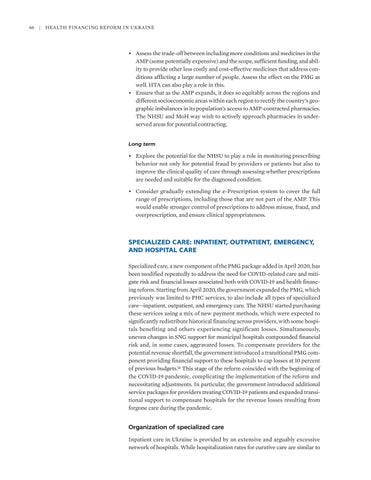66
| Health Financing Reform in Ukraine
• Assess the trade-off between including more conditions and medicines in the AMP (some potentially expensive) and the scope, sufficient funding, and ability to provide other less costly and cost-effective medicines that address conditions afflicting a large number of people. Assess the effect on the PMG as well. HTA can also play a role in this. • Ensure that as the AMP expands, it does so equitably across the regions and different socioeconomic areas within each region to rectify the country’s geographic imbalances in its population’s access to AMP-contracted pharmacies. The NHSU and MoH way wish to actively approach pharmacies in underserved areas for potential contracting. Long term
• Explore the potential for the NHSU to play a role in monitoring prescribing behavior not only for potential fraud by providers or patients but also to improve the clinical quality of care through assessing whether prescriptions are needed and suitable for the diagnosed condition. • C onsider gradually extending the e-Prescription system to cover the full range of prescriptions, including those that are not part of the AMP. This would enable stronger control of prescriptions to address misuse, fraud, and overprescription, and ensure clinical appropriateness.
SPECIALIZED CARE: INPATIENT, OUTPATIENT, EMERGENCY, AND HOSPITAL CARE Specialized care, a new component of the PMG package added in April 2020, has been modified repeatedly to address the need for COVID-related care and mitigate risk and financial losses associated both with COVID-19 and health financing reform. Starting from April 2020, the government expanded the PMG, which previously was limited to PHC services, to also include all types of specialized care—inpatient, outpatient, and emergency care. The NHSU started purchasing these services using a mix of new payment methods, which were expected to significantly redistribute historical financing across providers, with some hospitals benefiting and others experiencing significant losses. Simultaneously, uneven changes in SNG support for municipal hospitals compounded financial risk and, in some cases, aggravated losses. To compensate providers for the potential revenue shortfall, the government introduced a transitional PMG component providing financial support to these hospitals to cap losses at 10 percent of previous budgets.16 This stage of the reform coincided with the beginning of the COVID-19 pandemic, complicating the implementation of the reform and necessitating adjustments. In particular, the government introduced additional service packages for providers treating COVID-19 patients and expanded transitional support to compensate hospitals for the revenue losses resulting from forgone care during the pandemic.
Organization of specialized care Inpatient care in Ukraine is provided by an extensive and arguably excessive network of hospitals. While hospitalization rates for curative care are similar to

